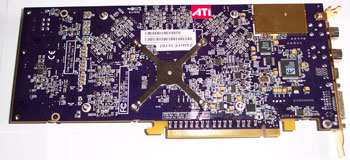All-In-Wonder Radeon X1900 Board Exam
Without an official XL base SKU to prove the connection, or perhaps the fact that there'll only be one X1900 AIW, ATI leave off the XL moniker for the AIW Radeon X1900. It's ostensibly an XL, though, going by ATI's previous track record in product naming.Clocked almost identically to the AIW Radeon X1800 XL, the AIW Radeon X1900 seeks to give its user a large chunk of the performance possible from the higher clocked Radeon X1900 XT and XTX products, despite only carrying half the memory. It's powered by the same R580 graphics processor, which out punches any other GPU in terms of fragment shader rate by some margin, and offers support for DirectX Shader Model 3.0 and the best 3D image quality possible on a consumer part.
Formal spec comes later, though. First, pictures.
The AIW Radeon X1900 reference board is at the top, AIW Radeon X1800 XL sitting beneath. The PCBs are identical, sharing the same part number, however the cooler is obviously different.
The heatsink shape is ever so slightly different, AIW Radeon X1900 retaining the same single-slot form factor that's so crucial to All-In-Wonder products. What's significantly different is the fan.
ATI furnish the X1900 version with a larger fan with more fins, compared to AIW Radeon X1800 XL (60mm vs 50mm). That allows for, logically at least, the same air volume moved but at slower fan speed, or more air moved at the same speed.
Outwardly - as measured by software at least - the fan speeds on both products are the same, with the same stepping levels from slowest to full. It seems ATI therefore equip the AIW Radeon X1900 with the larger fan to aid cooling performance. The bigger GPU under the cooler is likely the reason for that.
That doesn't mean the AIW Radeon X1900 is any louder than it's AIW Radeon X1800 XL brethren, however. Measured noise output is low enough to be tolerable to most in a HTPC environment, ATI tuning the speed steps for the fan to only spin up when absolutely needed, and the noise the AIW Radeon X1900 makes is no more (and less to our ears, although our SPL meter can't tell the difference) than the AIW Radeon X1800 XL.
The rear of the board has the Theater 200 ASIC and NxtWave NXT6000, while the front of the board gets R580 GPU, Microtune MT2121F silicon tuner, VIA VT1632M SCART output ASIC and eight 256Mib Samsung VC16 GDDR3 DRAMs.
The T200 (in shrunken package form) manages AV I/O side of things, capturing from and outputting to the 'domino' breakout boxes you'll connect to the main I/O cable, and processing output from the tuner can.
The NXT6000 does signal demodulation, error check and correction, and filtering, all for the Microtune tuner. As mentioned in our look at the All-In-Wonder Radeon X800 GT, the MT2121F and NXT6000 don't care where the signals are coming from; combined, they tune all internationally broadcast analogue and digital television and radio signals regardless of locale.
More on the tuning and I/O ability in coming pages.
The VC16 K4J55323QF memories on the AIW Radeon X1900 are the same lead-free packages that you'll find on a 256MiB GeForce 7800 GTX (as just one example).
The AIW Radeon X1900's connector backplane is identical to the X1800 version's, further cementing the fact that the X1900 version is only different in GPU and cooler. The PAL review sample means the fairly horrible push-fit connector types for antenna input, rather than the better screw types used elsewhere.
Left-to-right you get FM radio input, TV input (be that analogue terrestrial or DVB-T), the multi-I/O block connector and dual-link DVI output.
It's what connects to the multi-I/O block connector and DVI port, for getting the AIW to draw pixels on the displays ATI think you're likely to attach, that largely defines the AIW. Let's talk about those options.
Summary
The AIW Radeon X1900 retains the same one-slot form factor as all AIWs that precede it. The PCB might be longer than average, but it's still slim enough to fit into a suitable G5 Shuttle XPC (for example) without any issue.Packing an immense amount of I/O on the backplane while retaining the skinny form factor, all powered by a decent GPU, is The ATI All-In-Wonder Way™.












